
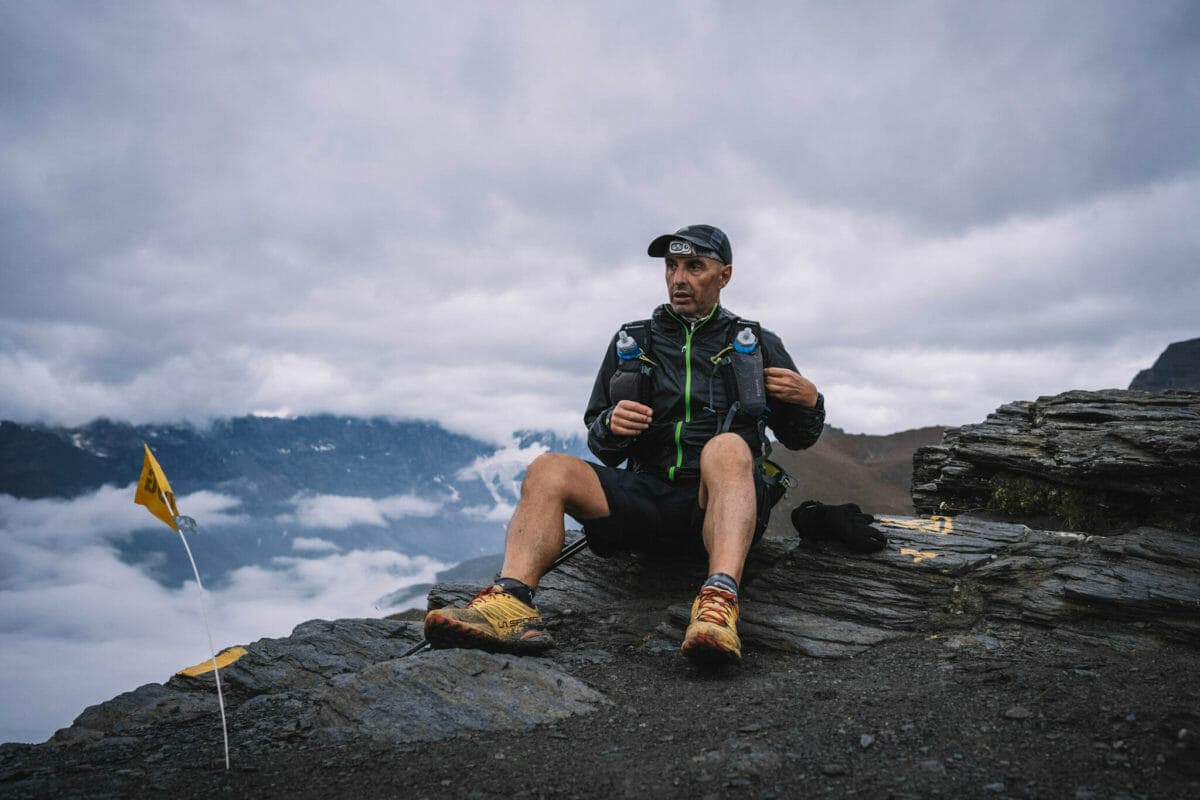
Here’s the Research Scientists have Done on Tor des Géants Runners
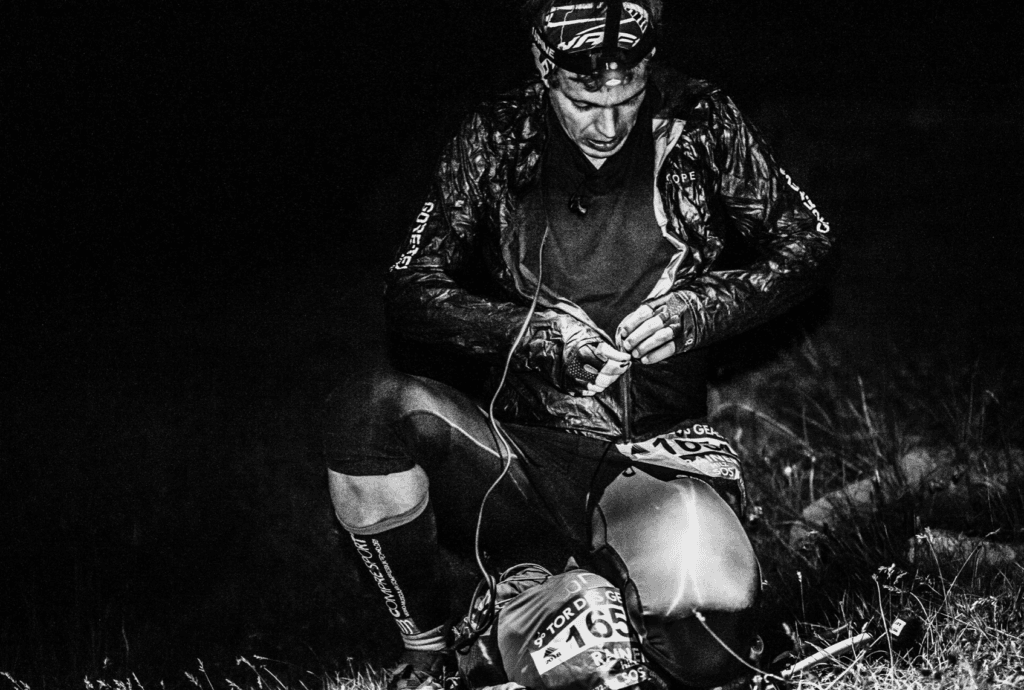
Canadian Ultrarunner Stephanie Case was about 290 kilometers into Italy’s epic 330-km long Tor des Gèants (TDG), a race with over 30,000 meters of climbing and descending, when she suddenly realized she was running with her longtime friend, Michael. She ran behind him and they chatted about all sorts of topics — his plans to do TDG next year, his nutrition strategy, the course, even the history of Tor.
After what Case guessed was an hour later, she woke up in a ditch at the bottom of the mountain. She had hallucinated Michael, and had sleep-run down technical mountain terrain before splatting face-first into the ditch.
This sort of sleep-running, hallucination, or dreamscape experience is a semi-regular occurrence for many TDG participants. So much so that researchers have studied Tor runners to try to understand why it happens.
In fact, scientists have done quite a bit of research looking into what happens to the body and mind of participants in Tor des Gèants. They’ve been running– pun intended– studies on it since nearly the inception of the event in 2010.
From sleep deprivation and muscle fatigue to lung function and heart health, researchers have covered nearly the whole spectrum of bodily functions to see what goes on during one of the hardest ultra-endurance events in the world.
We’ve compiled the studies that are publicly available, online, right here.
One note: While we’ve offered a layman’s overview of the research, we’re neither doctors nor researchers. Our take is just that of a casual reader. Please don’t act on our advice or guidance without consulting a medical professional.
Special thanks to Erica Motta at the VDA Trailers, the organization behind Tor, and Dr. John Anderson, a Tahoe, California-based doctor, ultrarunner, and Tor participant, who reviewed this article.
Now, let’s go through some of the most interesting findings from TDG research:
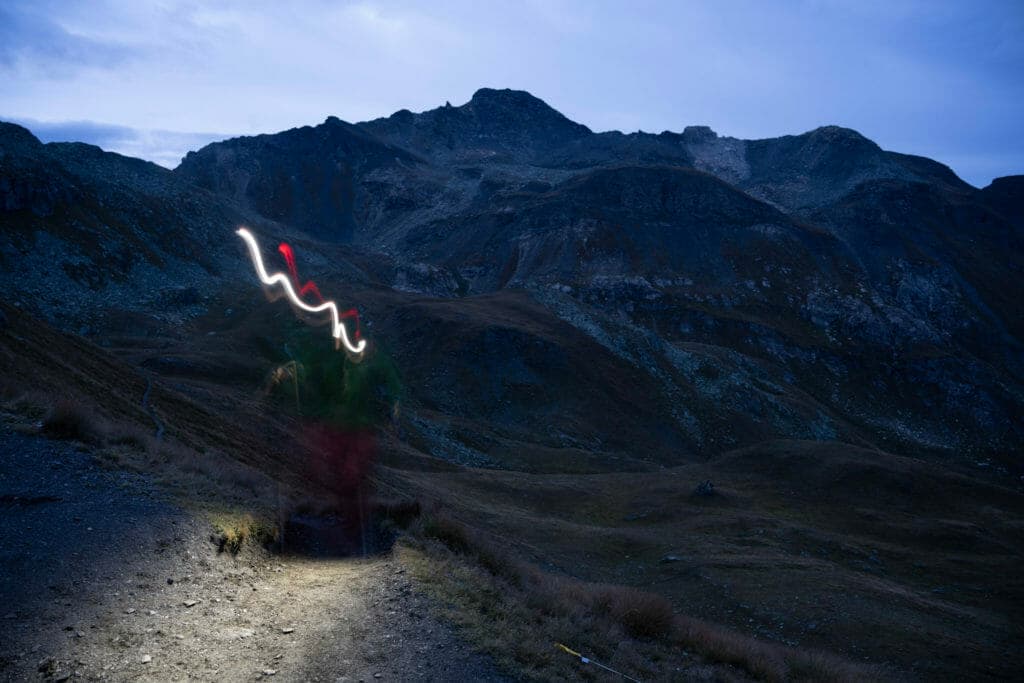
Brain and Psychological Research on Tor des Gèants
Researchers have spent a lot of time looking at what’s going on in the brain of runners during TDG. While there’s been loads of studies around sleep and sleep deprivation, the TDG offers a unique opportunity for scientists to see what happens to the mind after an uncommon cocktail of sleep deprivation, continuous exercise, altitude, and extreme weather conditions.
Most recently, Biological Psychology published a study in May 2022 about changes in spontaneous electrical brain activity among participants in TDG after they completed the event. Using high-density EEG, researchers Jérôme Spring, Etienne Sallard, Pietro Trabucchi (who we interviewed about the Zero edition of Tor), Grégoire Millet, and Jérôme Barral, measured wave frequencies in different parts of the brain in 16 finishers before and after the race.
What they found corresponded with what any Tor finisher would likely tell you: their brain and pace of their thoughts slowed down, as though they were in a half-sleep, dream-like state. The study concludes, “Thus, we assume that the participants were in an intermediate state of consciousness between waking and sleeping, which is often associated with hypnagogic imagery.” That is, possibly the sort of experience that Case had during her imagined conversation with Michael.
Before this recent study, there were a handful of studies looking at brain and mental function during Tor. One study from 2017 measured water diffusivity and volume in the brain before and after TDG. It showed that finishers had higher water volume in their brain at the end than at the start, but then had even lower water volume 48 hours after the race than they did at the start. The study notes, “48-72 hours after the finish line, the brain hasn’t fully recovered, though it’s hard to speculate exactly what that means.”
Two other studies from 2018 and 2020 took a more experiential approach rather than physical measurements. The first, from 2018, analyzed interviews with participants and found three categories of thoughts that the runners often had: “controlling global ease, enduring general fatigue and experiencing difficult situations, and feeling freedom in the running pace.”
The second, from 2020, dug into more of those hallucinations and misperceptions that so many Tor runners talk about. The researchers were able to separate them out to three main types:
- Misperceptions like depersonalization or distortions of one’s surroundings, time, or distance
- Illusions
- Hallucinations
Out of 17 athletes, 14 had visual misinterpretations, the majority of which were “imaginative reworking of clouds, rocks, bushes, or trees, interpreting them as fantastic beasts, such as dragons, goblins, or gremlins.” One TDG runner in the study even reported a complex hallucination with family members appearing and running with him for several kilometers, similar to Case’s experience.
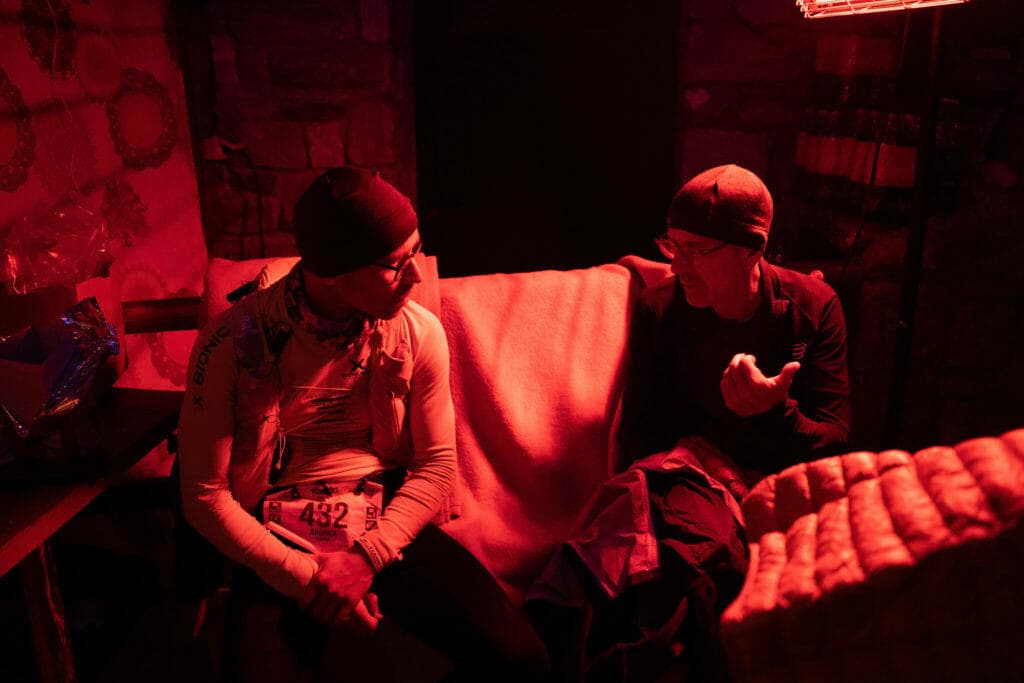
Heart, Lungs, and Stomach: Research on the Rest of the Body from Tor
How the Heart Copes
Researchers have been especially interested in how the heart and cardiovascular system cope with a race the magnitude of Tor. The most recent studies had a mix of results. Here’s a brief overview:
In the March 2022 paper, “Kinetics of Cardiac Remodeling and Fibrosis Biomarkers During an Extreme Mountain Ultramarathon,” researchers tracked the levels of certain cardiac fibrosis biomarkers. These markers are often associated with heart failure and other cardiovascular diseases. What they found was that after the midway testing point (148 km), the biomarkers started to decrease and recover. The authors wrote, “Overall, performing at such an extreme ultramarathon seems less deleterious for the heart than shorter events.”
Lungs take a Beating
While some parts of the body might start recovering during the second half of Tor, the lungs apparently did not. A 2014 study found a continuous decline in lung function throughout the race.
Easing Impact on the Digestive Tract
Having some form of stomach or GI distress might be one of the more common issues Tor participants battle with during the race. Abdominal pain, bloating, diarrhea, vomiting, nausea, heartburn, stitches, you name it, and more than a few folks on Tor have probably dealt with it.
If you needed any more incentive to take an electrolyte supplement, well, this just might be the study for you! Researchers from a 2015 study measured how much a supplement mix could improve runners’ odds of avoiding GI issues that take them out of the race. This study — “Prevention of acute GI disturbances with a functional food formulation designed to support and maintain intestinal barrier function during sports performance” — tested a specific nutrient powder mix with 47 Tor athletes during the 30 days before the race and during the race itself. The results suggested that taking the powder mix made the athletes less likely to have severe GI issues that caused them to drop out of the race than the control group.
You can see what the study’s powder mix contained in this nutrition chart.
Muscular and Skeletal Fatigue and Energetics
Learning how the muscular system copes during TDG was one of the first topics researchers studied about the race, back in 2013. After approximately 130 hours of almost constant running or hiking, it makes sense that one of the first things researchers would ask is how the legs handle it.
The result? Muscles actually coped better during TDG than on other mountain ultra-marathons (MUMs). The 2013 study, Alterations of Neuromuscular Function after the World’s Most Challenging Mountain Ultra-Marathon, concludes, “paradoxically, such extreme exercise seems to induce a relative muscle preservation process due likely to a protective anticipatory pacing strategy during the first half of MUM and sleep deprivation in the second half.”
More recently, research from 2016 and 2017 found that over the course of the race, runners actually became more efficient hiking uphill. The study from November 2016, An Extreme Mountain Ultra-Marathon Decreases the Cost of Uphill Walking and Running, collected data using treadmill exercises with 19 male runners in TDG. The study found that even though the athletes were tired at the end of the race, they kept the same gait they had before the race and they used less energy to do it.
The researchers speculated that after 130 hours of the same repetitive movements, the body was able to adapt to become more efficient at doing those motions.
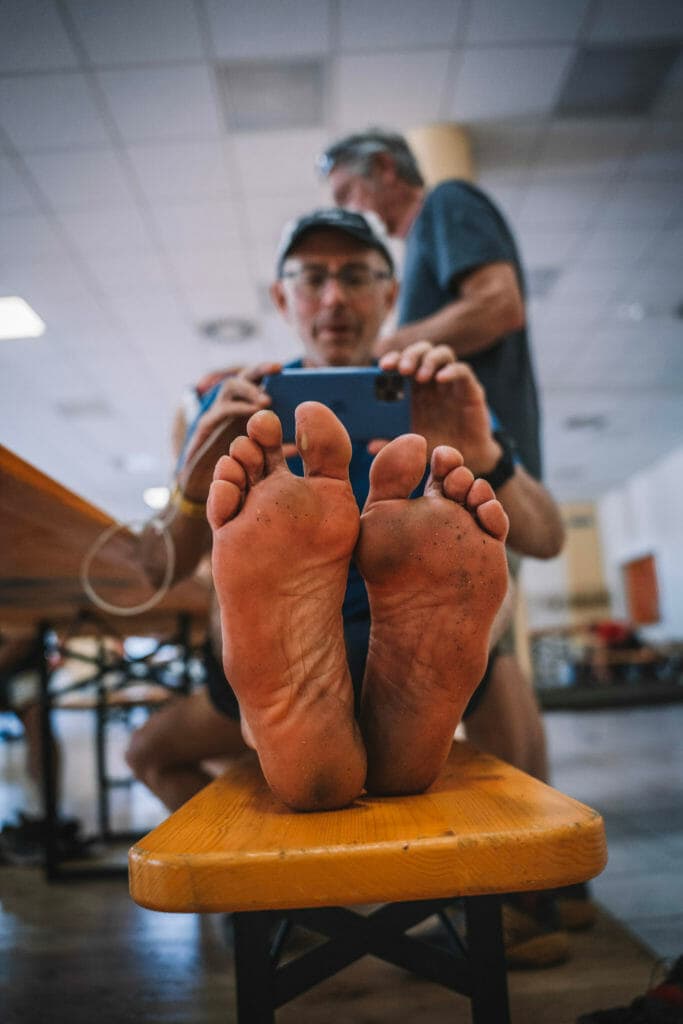
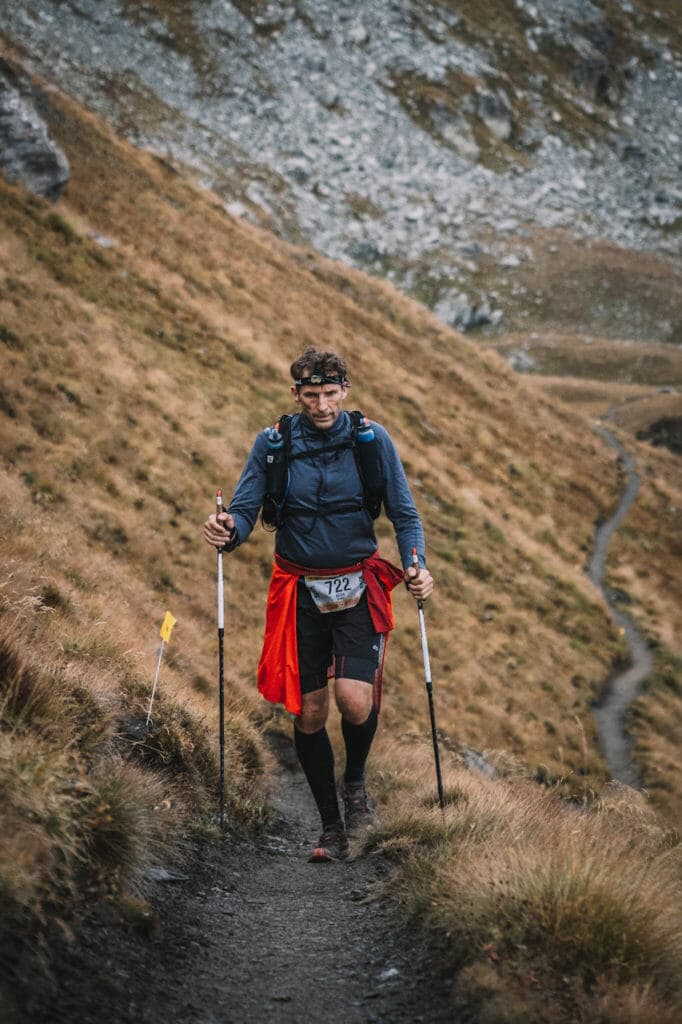
A Disclaimer
When we note the various findings from research on TDG participants, it can be easy to think, oh, that makes sense. But it’s pretty interesting to see that the results from research often confirm what Tor runners have anecdotally experienced.
Now, here’s the big caveat with many of these studies: they are far from being any sort of clear understanding, much less “proof.” Almost all of the studies have relatively low sample sizes. That’s fair enough, as researchers don’t have a huge pool of TDG participants from which to pull. But it also means that there’s room for error, and therefore all of these studies should be taken with a healthy dose of skepticism.
A 2020 article published by Vox also notes issues in replication. “Researchers have discovered, over and over, that lots of findings in fields like psychology, sociology, medicine, and economics don’t hold up when other researchers try to replicate them.”
Furthermore, it’s important to note that these studies are skewed toward male participants and offer very little data about female participants.
For information about the researchers, details of their materials and methods, the study sample, and the conclusions from the research, we recommend going straight to the source, and enlisting the help of a researcher or other medical professional who can interpret the results based on professional training.
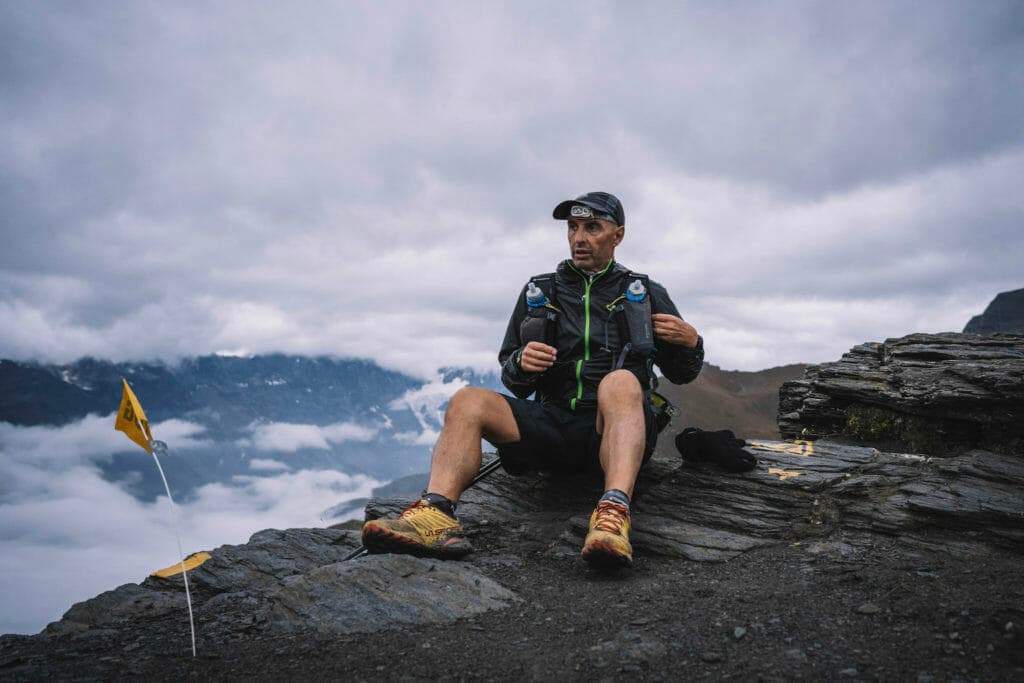
Tor des Géants Medical Studies
These are all the studies about Tor des Géants we could find which are publicly available. We’ve listed them by publication date and added our own brief summary for the studies we found most interesting. If you have a study to add, please let us know!
- Millet, Guillaume Y. “Can neuromuscular fatigue explain running strategies and performance in ultra-marathons?: the flush model.” Sports medicine (Auckland, N.Z.) vol. 41,6 (2011): 489-506. doi:10.2165/11588760-000000000-00000
Run the Alps Summary: This is a review article, meaning it’s an overview of previously published research, but didn’t have any primary research of its own. It covers different ideas for how and why changes happen to neuromuscular function during an ultra-marathon. The article proposes “the flush model” as a holistic way to view the relationship between the body and completing an ultra-marathon with all the different competing factors at play.
- Saugy, Jonas et al. “Alterations of Neuromuscular Function after the World’s Most Challenging Mountain Ultra-Marathon.” PloS one vol. 8,6 e65596. 26 Jun. 2013, doi:10.1371/journal.pone.0065596
Run the Alps Summary: This study tested neuromuscular fatigue, comparing 13 TDG finishers to a control group with similar levels of sleep deprivation. They measured blood markers of muscle inflammation and found differences in the tests between pre, mid, and post in the runners, but not for the control. The findings also showed “less neuromuscular fatigue, muscle damage and inflammation than in shorter MUMs.”
- Vernillo, G et al. “Changes in lung function during an extreme mountain ultramarathon.” Scandinavian journal of medicine & science in sports vol. 25,4 (2015): e374-80. doi:10.1111/sms.12325
Run the Alps Summary: This study tracked 29 male ultra runners and took measurements on different lung function tests before, during, and after TDG. The researchers saw a continuous decline in pulmonary function during the Tor.
- Degache, Francis et al. “Alterations in postural control during the world’s most challenging mountain ultra-marathon.” PloS one vol. 9,1 e84554. (21 Jan. 2014) doi:10.1371/journal.pone.0084554
Run the Alps Summary: This study showed that runners took longer to stabilize their body after the race than before or during. The researchers assessed postural control (the ability to accurately control your own body) before, during, and after TDG and found that TDG had significant effects on postural control and response time.
- Vernillo, Gianluca et al. “Influence of the world’s most challenging mountain ultra-marathon on energy cost and running mechanics.” European journal of applied physiology vol. 114,5 (2014): 929-39. doi:10.1007/s00421-014-2824-y
Run the Alps Summary: This study tested 10 male ultra runners before and after TDG measuring changes in energy cost of level and uphill running and cycling. The only changes they found were in the uphill running where energy cost decreased by 13.8%. “After this extreme mountain ultra-marathon, the subjects modified only their uphill-running patterns for a more economical step mechanics.”
- Maufrais, Claire et al. “0108: Specific alterations in cardiac function induced by a 300 km mountain ultra-marathon.” Cardiovascular Diseases Supplements vol. 6, Supplement 1 (2014) doi:10.1016/S1878-6480(14)71466-1
- Visconti PT-OMT, Lorenzo et al. “Effect of massage on DOMS in ultramarathon runners: A pilot study.” Journal of Bodywork and Movement Therapies vol. 19,3 (2015): 458-463. doi:10.1016/j.jbmt.2014.11.008
Run the Alps Summary: This study looked at delayed-onset muscle soreness (DOMS) during TDG and the effect massage had on that soreness and recovery during the race. Researchers concluded, “Massage appears to be a safe and effective treatment to treat DOMS-related pain.” They noted that runners found it most positive during the peak of DOMS symptoms.
- Viallon, Magalie et al. “MUST project: a quantitative MRI evaluation of structural and functional changes in myocardial and skeletal muscles induced by ultra-endurance running.” MAGNETOM Flash (2015).
- Andrea Borghini, Guido Giardini, Alessandro Tonacci, Francesca Mastorci, Antonella Mercuri, Simona Mrakic Sposta, Sarah Moretti, Maria Grazia Andreassi, Lorenza Pratali, “Chronic and acute effects of endurance training on telomere length.”, Mutagenesis, Vol. 30,5 (2015): 711–716. https://doi.org/10.1093/mutage/gev038
- Goff CL, Kaux J, Gergelé L, et al. “Impact Of An Ultra-Marathon Of 330 Km On Plasma Levels Of Cardiac Biomarkers.” British Journal of Sports Medicine 2017;51:348.
- Vitiello, D., Degache, F., Saugy, J.J. et al. “The increase in hydric volume is associated to contractile impairment in the calf after the world’s most extreme mountain ultra-marathon.” Extrem Physiol Med 4, 18 (2015). https://doi.org/10.1186/s13728-015-0037-6
- Degache, Francis et al. “Running Mechanics During the World’s Most Challenging Mountain Ultramarathon.” International journal of sports physiology and performance vol. 11,5 (2016): 608-14. doi:10.1123/ijspp.2015-0238
- Mrakic-Sposta, Simona et al. “Effects of Mountain Ultra-Marathon Running on ROS Production and Oxidative Damage by Micro-Invasive Analytic Techniques.” PloS one vol. 10,11 e0141780. 5 Nov. 2015, doi:10.1371/journal.pone.0141780
- Sponsiello N, et al. “Prevention of acute GI disturbances with a functional food formulation designed to support and maintain intestinal barrier function during sports performance.” Progress in Nutrition Vol. 17, N. 4 (2015): 317-313.
Run the Alps Summary: Researchers tested a mix of nutrients and antioxidants with Tor participants to see if it would decrease the dropout rate due to gastrointestinal issues. The study showed that 4.2% of participants who used the mixture, even if on an irregular basis, pulled out of the race due to GI issues compared to 11.3% of the control group participants who pulled out due to GI issues.
- Maufrais, Claire et al. “Progressive and biphasic cardiac responses during extreme mountain ultramarathon.” American journal of physiology. Heart and circulatory physiology vol. 310,10 (2016): H1340-8. doi:10.1152/ajpheart.00037.2016
Run the Alps Summary: This study assessed cardiac responses during TDG. The test subjects were 15 male participants. The researchers measured different cardiac functions before, in the middle, and after the race. The study showed that TDG induced a two-phased heart pattern similar to a cardiac response that has a progressive increase in pumping out blood.
- Tonacci, Alessandro, et al. “A novel application for cognitive evaluation in mountain ultramarathons: olfactory assessment.” Wilderness & environmental medicine 27.1 (2016): 131-135.
Run the Alps Summary: This study measured sense of smell, a biomarker for cognitive impairment, during TDG over two years of TDG (2013 and 2014) with a total of 53 participants. Researchers used an odor identification test before, around the middle (148.7 km), and after Tor. Researchers also looked at dehydration and sleep deprivation at each time and had a control set of athletes who were not running TDG.
The study showed that the sense of smell decreased throughout the race. While there was no significant correlation between change in smell and race time or sleep deprivation, the challenges through the second half of the race did seem to show a decrease in smelling ability.
- Gilles, Benjamin, et al. “Automatic segmentation for volume quantification of quadriceps muscle head: a longitudinal study in athletes enrolled in extreme mountain ultra-marathon.” ISMRM: International Society for Magnetic Resonance in Medicine. 2016.
- Vernillo, Gianluca, et al. “An extreme mountain ultra-marathon decreases the cost of uphill walking and running.” Frontiers in physiology 7 (2016): 530.
Run the Alps Summary: This study measured energy cost and kinematics of different uphill gaits from 19 male TDG runners before and after the race. The results essentially showed that after TDG, runners used less energy on the treadmill exercises, while the actual way their bodies moved, didn’t change significantly. The researchers hypothesized that the repetitive walking and running movements over such a long period made the body adapt to become more efficient, which outweighed constraints from the physical fatigue or challenge.
- Vernillo, Gianluca, et al. “Effects of ultratrail running on skeletal-muscle oxygenation dynamics.“ International Journal of Sports Physiology and Performance 12.4 (2017): 496-504.
Run the Alps Summary: The purpose of this study was to measure changes in muscle oxygen usage and how well the lungs were able to take in oxygen during TDG. The study had 14 athletes and 12 control adults. The researchers measured different oxygenation factors in the largest muscle of the quadriceps during two 4-minute cycling bouts. After TDG, athletes showed more muscle deoxygenation and an altered balance between oxygen delivery to muscles and the muscle consumption of oxygen.
- Zanchi, Davide, et al. “Extreme mountain ultra-marathon leads to acute but transient increase in cerebral water diffusivity and plasma biomarkers levels changes.” Frontiers in physiology 7 (2017): 664.
Run the Alps Summary: This study used MRI and blood parameters to measure the amount of water in the brains of 19 TDG athletes in order to investigate brain water diffusivity and contribute to research around cerebral edema — meaning brain swelling due to fluid in the brain, which can be potentially life threatening. Researchers took MRI scans and “brain diffusion-weighted images (DWI)” before, at the end, and 48 hours after the race. The results showed that at the end of the race, athletes had higher water volume in the brain than at the start. At 48 hours, the water volume dipped below the start, signaling the body had not yet fully recovered to the equilibrium state.
- Savoldelli, Aldo, et al. “The energetics during the world’s most challenging mountain ultra-marathon—a case study at the Tor des Geants®.” Frontiers in physiology 8 (2017): 1003.
- Rochat, Nadège, et al. “Enacting phenomenological gestalts in ultra-trail running: an inductive analysis of trail runners’ courses of experience.” Frontiers in psychology 9 (2018): 2038.
Run the Alps Summary: This study interviewed 10 participants from TDG, collecting information about their past race activity and conducting enactive interviews about the experience of TDG. The researchers used a coding method to separate the experiences into different categories: “controlling global ease, enduring general fatigue and experiencing difficult situations, and feeling freedom in the running pace.”
- Nguyen, Hoai-Thu, et al. “Evaluation of local changes in femoral bone marrow during a mountain ultra-marathon with quantitative MRI.” ISMRM: International Society for Magnetic Resonance in Medicine. Montréal (2019).
- Le Goff, Caroline, et al. “Impact of participating to a 330 km long ultra-trail versus a 67 km short ultra-trail on muscular and cardiac genetic regulation by microRNAs.” 24th Annual Congress of the European College of Sport Science. 2019.
Run the Alps Summary: This study compared TDG with the Ultra Tour de Liège (UTL 67 km) in Belgium, using blood samples and looking at specific microRNAs that indicate “suffering” of the skeletal and heart muscles. The results showed an increase in suffering in the skeletal and heart muscles in both races and even after the recovery period (3 days for TDG), they were not back to normal. However, neither showed permanent damage to the heart.
- Carbone, Manuel Glauco, et al. “Misperceptions and hallucinatory experiences in ultra-trailer, high-altitude runners.” Rivista di Psichiatria 55.3 (2020): 183-190.
Run the Alps Summary: This study classified different “misperceptions” from 21 athletes, 20 male, 1 female. The researchers categorized the misperceptions into three different clusters: 1) anomalies in perceptions – depersonalization and derealization; 2) illusions; 3) hallucinations.
17 out of the 21 runners experienced some sort of visual misinterpretation, which the researchers found surprising and as potential to study hallucinatory events without the presence of medical or psychiatric disorders or hallucinatory substances.
- Le Goff, Caroline, et al. “297 Cardiac fibrosis markers: galectin-3 and suppression of tumorigenicity 2 measurement in participant at the Tor des Géants.” (2021): A115-A115.
- Le Goff, Caroline, et al. “Kinetics of cardiac remodeling and fibrosis biomarkers during an extreme mountain ultramarathon.” Frontiers in Cardiovascular Medicine 9 (2022).
Run the Alps Summary: This study collected blood samples from 50 experienced runners in TDG at four periods of the race — before, at 148 km, at the finish line, and 3 days after the recovery period. They looked at cardiac fibrosis biomarkers and found they were at the highest at 148 km then started to decrease and recover through the second half and after.
- Spring, Jérôme N., et al. “Alterations in spontaneous electrical brain activity after an extreme mountain ultramarathon.” Biological Psychology (2022): 108348.
Run the Alps Summary: This study looked at spontaneous electrical brain activity in 16 finishers of TDG using EEG recordings (electroencephalogram – measuring brain waves of different frequencies). They found that different regions in the brain showed lower frequencies, which would indicate “active” intelligence, and higher frequencies of brain waves, which would occur more during deep sleep.